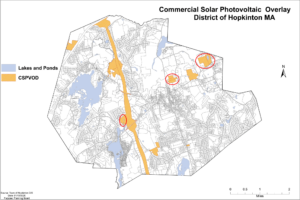
The Commercial Solar Photovoltaic Overlay District map that the Planning Board voted to send to Town Meeting consists of the properties above minus the three parcels circled in red. The Frankland Road project is the one circled on the far right.
At its meeting Monday night, the Planning Board discussed how to handle issues with the Commercial Solar Photovoltaic Overlay District map that it approved on June 1 and sent to September’s Town Meeting warrant. There had been some confusion recently regarding the overlay proposal and its effect on a current solar special permit project on Frankland Road. The Planning Board originally thought the Seaboard Solar project would be grandfathered in regardless of the overlay status.
“The issue tracks back to the statutes,” town counsel Bryan Bertram, of Miyares & Harrington LLP, said during the meeting.
According to MGL Chapter 40A, Section 6, “A zoning ordinance or bylaw shall not apply to structures or uses lawfully in existence or lawfully begun, or to a building or special permit issued before the first publication of notice of the public hearing.” This means that the solar project off Frankland Road will not be grandfathered in, and although the board issued a special permit for the project at Monday’s meeting, it could be negated by a Town Meeting vote in favor of the proposed solar overlay district — which does not include the Frankland Road parcel.
“That risk is really on [Seaboard Solar] at this point,” Bertram said. “This location is not allowed in the overlay district.”
Planning Board chair Gary Trendel clarified that even though a special permit was approved, if the overlay map is approved there could be a legal process by which the special permit could still go forward if the overlay is challenged and overturned completely.
“I think that’s definitely a risk,” Bertram said.
However, Trendel said he wanted to be clear that the discussion of the overlay did not weigh on the board’s decision of a special permit for the Frankland Road project.
Bertram explained that if submitted to the attorney general’s office, the solar overlay plan as currently proposed likely would be approved. However, he said that the attorney general process looks only at the four corners of the bylaw itself, that officials likely wouldn’t even look at a map, and that the decision likely would be approved with an attorney general caution.
“It would not stand up in a court hearing,” he said. “You could absolutely face a lawsuit over this. We definitely have concerns.”
Town counsel’s chief concern is that the areas the overlay indicates would be approved for solar are very small. Bertram said the statute itself says towns can’t prohibit solar projects, but they also cannot unreasonably regulate the installation of these facilities by restraining them to certain locations in the town.
“It’s in our best interest to revisit this and discuss it and figure out next steps,” Trendel said.
Trendel said he saw three options for the overlay dilemma. Option 1 was to allow the process to continue and leave the recommended article as is. Option 2 was to conduct a new hearing and reopen this article and reevaluate which parcels to include and attempt to do that before September’s Town Meeting. Option 3 was to withdraw the article and send it back to the Zoning Advisory Committee (ZAC) and ask ZAC to put some additional diligence into evaluating which parcels should be considered.
Trendel said he preferred the third option.
“I’ve struggled a lot with this because I do think we need some additional guidance about where solar belongs,” he said. “At the same time I think this has been a tricky process anyway with timing. Town Meeting has already been pushed back and I don’t think we’d lose as much time as we would under normal circumstances.”
Bertram said town counsel would support the third option as well.
“We want to make this the most defensible we can and make sure it holds up,” he said.
Trendel said he was not only thinking about defensibility in court, but the ability to get it to pass at Town Meeting.
“We have a higher likelihood of getting it through Town Meeting if we do withdraw it and we really think through the criteria,” he said.
Planning Board member David Paul said he liked the idea of Option 1.
“We’ve been kicking this around for a number of years and nothing has been done,” he said. “In the meantime we keep getting more and more clear-cutting of trees. It’s better to have something in place than nothing.”
He also pointed out that he wanted to see how the townspeople feel about the overlay, as the Planning Board typically only hears from a small number of residents.
Planning Board member Jane Moran said to her it comes down to private property rights vs. the rights of abutting landowners.
“I think what’s missing is specifics,” she said. “We haven’t really addressed how is this zoning bylaw going to affect future growth?”
Ultimately she agreed with Option 3, having the language be reworked.
Planning Board member Mary Larson-Marlowe, who also is a member of the Zoning Advisory Committee, said logistically, considering ZAC hasn’t been meeting due to COVID restrictions, she didn’t think a new plan would make the January deadline for the next Annual Town Meeting.
“I think additional work can be done, but that doesn’t mean it has to come out of the agenda,” she said. “As a member of ZAC, it has been very frustrating. There is very little input from the public and then it comes to Planning Board and we get a lot of input from public. But when we go to Town Meeting it might be a totally different story.”
Considering this, she supported Option 1.
Planning Board members Sundar Sivaraman and Muriel Kramer also supported Option 1.
“This is a really gnarly set of questions,” Kramer said. “The reason it didn’t get done before is because it’s so challenging.
She said it is important to remember that zoning is about the ways land is used appropriately, and it doesn’t matter who owns it.
“I think the public is very interested in controlling the uses of commercial properties,” she said. “I think we really do want to have that discussion and disincentivize clear-cutting trees. I think it’s time to ask the Town Meeting voters to weigh in on this. If the town is behind this, that is an indicator to developers where we want them to pursue to putting solar, and it’s our right to do that.”
Planning Board member Deborah Fein-Brug said she was torn but ultimately went with Option 1 as well.
“I would hope to allow the process to continue because I do think our environment is affected by these developments,” she said. “I would like town counsel to reevaluate the properties we could use but would like to allow the process to continue and take it to town meeting.”
The board agreed by majority to leave the proposed solar overlay district as is on the Town Meeting warrant.














0 Comments